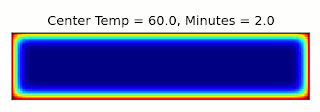[Programming Note: I've noticed looking through older posts that the equations have picked up extra + signs, due to my impolite hotlinking. I plan to go through and fix those when I have a chance, but until then, don't take them at face-value.]
Another great question from a reader, this time my own mother, Sally:
I’m making a carrot cheesecake for Steve’s birthday. The cheesecake layer is supposed to go into an 9” springform pan but I only have 8”[...] I assumed I’d just make the cheesecake layer thicker, but how to determine baking time? The volume is the same but the height is 25% greater. Thicker tends to mean longer baking. But how do i determine that? What role does oven temp play? What role does moisture level of cheesecake play?
I've talked about heat transfer before, in
this post about making granita, but I'd like to take a different approach this time, using the more general heat equation:
This says that the rate of temperature change at a point in the cake is proportional to the variation in temperature nearby, and the
thermal diffusivity, α. This quantity depends on the substance we're interested in, but I don't think it's been tabulated for cheesecake batter, so we'll assume it's about the same as water, 0.143 × 10
−6 m
2/s [this is the role the moisture level plays].
Technically, this is a 3-dimensional problem, but thanks to the cylindrical symmetry of the cake, we can just consider a 2d cross-section through the center. We can assume the outer surface of the cake is fixed at the oven temperature, 325°F. Then we can use a numerical solver to find the temperature throughout the cake over time. As it happens, I wrote a solver for this equation a few years ago for a Computational Physics class. After a few adjustments, it was ready to go:
bake.py
First, we need to find the internal temperature that the cake reaches after the prescribed 45 minutes of baking.
The final temperature after 45 minutes is 206°F. This is a little close to the boiling point of water, 212°F, where I expect things to get a bit off from the approximations I'm making, but we'll go with it. Then we can start again with a narrower cake of the same volume, and find how long it takes to get to that temperature.
The final time is about 70 minutes, which isn't completely unreasonable, but I take no responsibility for any charred cakes this calculation results in. Thanks for a great question, Sally!
[Edit: One first posting, I mistakenly used 8/9" as radii, rather than diameter. It doesn't actually make a difference in the final results, since the thickness dominates.]










































